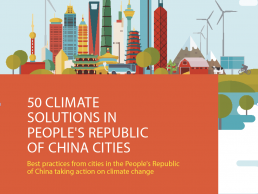First appeared in

Asian Development Bank
50 climate solutions from cities in the People's Republic of China
State-of-the-art battery technology enables electric trams to fully recharge in just 30 seconds. With a 20 km long route, Huai’an has introduced the longest running electric tram using supercapacitors in the world.
Huai’an has implemented one of the first electric trams powered by supercapacitors to run on a 20 km route, servicing 23 stops in the busiest area of the city. Supercapacitor technology has a number of advantages over regular batteries, with a 30 second recharging time and long lifetimes. This means, that Huai’an’s trams can run all day every day for up to ten years, recharging at each stop on the line. The trams also use energy recovery technology to salvage 85% of the energy generated from braking.
4.9K
TONS OF CARBON EMISSIONS REDUCED ANNUALLY BY SHIFTING JOURNEYS TO LOW- CARBON TRAMS.
With no need for overhead cables to power the trams, infrastructure and maintenance costs are significantly reduced, and the system is less vulnerable to adverse weather conditions. The CNY 3.7 billion project carried 7 million passengers in 2016, with about 30% of journeys replacing private car trips, avoiding roughly 4,900 tons of CO2 emissions annually. While many cities are using electric trams and buses, this is one of the first in the world to use supercapacitors for energy storage, and plans are afoot to expand the service even further.

One of the world’s first electric trams using supercapacitors for energy storage has been implemented in Huai’an.
The Challenge
Rapid population growth and increased car ownership has created serious congestion and air pollution problems in Huai’an. By expanding energy efficient, affordable and convenient public transport options, the city is minimizing the number of cars on the road and reducing energy demand on the city’s coal-fired power stations.
Co-Benefits
Economic The CNY3.7 billion investment in Huai’an’s tram infrastructure is expected to boost local GDP by CNY 9.7 billion.
Environment The supercapacitor tram will reduce annual hydrocarbon and NOx emis- sions by 196 and 490 tons respectively, improving air quality for the city’s 5.7 million citizens.
Health Shifting journeys from private cars to low-carbon trams not only reduces the chance of respiratory illness, but also encourages more active lifestyles in the city.

